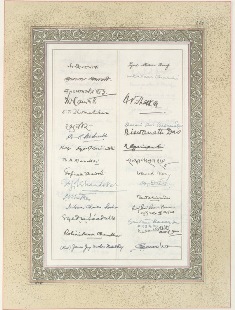
They wrote India’s Constitution while Belli rode his tricycle
By C.P. Belliappa
It was in December 1946, that a Constituent Assembly was constituted, and it took 3 years for the august body to draft the historic document which enshrines the guiding principles of this country.
Members who were active in the nationalist movement were inducted through indirect elections from the central and provincial Assemblies to represent a broad cross-section of the country.
The Assembly was further strengthened by inducting legal luminaries such as Dr B.R. Ambedkar, K.M. Munshi, Gopalaswamy Iyangar, K.T. Shah et al., even though they did not participate in the freedom movement. My father C.M. Poonacha represented Coorg, and at 36 years of age, was one of the youngest members.
One of the earliest decisions taken was to avoid the constitution being written only by technical experts or the elite-bureaucracy. (Pakistan took this route, and their constitution has been re-written three times!) The Indian constitution was drafted through a combination of ‘democratic-consensual’ and ‘elite-bureaucratic’ approach. This has resulted in a resilient document which has stood the test of time for 65 years.
Another unique feature in drafting the constitution was to pass every resolution unanimously after extensive consultations. Thus, every clause in the constitution was discussed till all the members of committees and sub-committees agreed without dissent. None of the resolutions were put to vote to avoid ‘tyranny of the majority’.
The final draft of the Constitution of India was signed and adopted on 26 November 1949. C.M. Poonacha was one of the signatories (see image). The Constitution of India was brought into force on 26 January 1950 when India was declared a sovereign Republic.
One more distinctive narrative in the Constitution of India is that the nation expects excellence from every citizen. Well, that is least practiced in recent years, especially by the elected representatives!
Now, the tricycle!
During the course of his duties in the Constituent Assembly, my father took us to Delhi a couple times. My age was in single digits and my sister Vijay was an infant. However, I have vivid memories of Delhi at the time. Most of the Constituent Assembly members who came from other parts of the country were housed in ‘Constitution House’ on Janpath Road. (It does not exist any longer.) The accommodation was modest – a studio apartment in a double-storied building complex.
One evening we were window shopping in Connaught Place when a toy-shop attracted my attention. I peeled off and stood watching in awe the colourful toys. I then spotted a tricycle which had a horse head, and a horn with a rubber bulb, on its handle. I gingerly asked my father if he could buy it for me. ‘No, No, it’s expensive and I don’t have the money for it,’ he said. My eye welled up and I beseeched him again. The shopkeeper came just then which encouraged me. ‘Your young boy likes the tricycle sir,’ he said to my father. My parents wanted to distract me and exit the shop. I started howling and held on to the tricycle. No amount of cajoling would make me relent. Finally, my father tried to pacify me by saying that we would return the following day with the cash. But I stuck to my guns and yelled – ‘Nakk ikka bondu.’ I soon attracted the attention of others in the shop and my parents were thoroughly embarrassed. I kept screaming – ‘Nakk ikka bondu…’
The kindly shopkeeper suggested that the payment could be made the following day. My father had no other option! I proudly cycled my new possession right from the shop to the tonga we took back to Constitution House!
Back in the Constitution House, I happily cycled all along the corridors. Many luminaries framing the Indian constitution would chat me up and admire my tricycle!

